Family: Tenthredinidae
Family common name: common sawflies
Subfamily: Tenthredininae
Tribe: Sciapterygini
Genus: Filacus Smith & Gibson, 1984
Subgenera: none
The Tenthredinidae are the most species-rich family and are found throughout the world, in all continents but Antarctica. They are known as the “common sawflies.” They can generally be recognized by a cylindrical body and long, segmented antennaeantenna:
the sensory organ emerging from the front of the head, usually between the compound eyes and above the clypeus; includes the flagellum, scape and pedicel
 . Otherwise, they come in a variety of colors, sizes, and forms (Goulet 1992Goulet 1992:
. Otherwise, they come in a variety of colors, sizes, and forms (Goulet 1992Goulet 1992:
Goulet H. 1992. The genera and subgenera of the sawflies of Canada and Alaska: Hymenoptera. Symphyta. The insects and arachnids of Canada. Part 20. Agriculture Canada Publication.).
Sawflies in the Tenthredininae subfamily are relatively large compared to others in the family, often with distinct colorful markings. Some are wasp-like with black and yellow stripes (Goulet 1992Goulet 1992:
Goulet H. 1992. The genera and subgenera of the sawflies of Canada and Alaska: Hymenoptera. Symphyta. The insects and arachnids of Canada. Part 20. Agriculture Canada Publication.). Many species’ life histories are not known. Some Tenthredininae species feed uniquely, as adults, on flower pollen and other insects (Smith 1993Smith 1993:
Smith DR. 1993. Systematics, life history, and distribution of sawflies. Pp. 3-32. In: Wagner MR and Raffa KF, eds. Sawfly Life History Adaptations to Woody Plants. University of Minnesota Academic Press. 581 pp.). They can be distinguished from other subfamilies by wing venationvenation:
the network of veins on a wing
(Goulet 1992Goulet 1992:
Goulet H. 1992. The genera and subgenera of the sawflies of Canada and Alaska: Hymenoptera. Symphyta. The insects and arachnids of Canada. Part 20. Agriculture Canada Publication.).
Filacus is a western North American genus of small, stout, black and yellow sawflies (Smith and Gibson 1984Smith and Gibson 1984:
Smith DR and Gibson GAP. 1984. Filacus , a new genus for four species of sawflies previously placed in Macrophya or Zaschizonyx (Hymenoptera: Tenthredinidae). Pan-Pacific Entomologist 60 (2): 101-113.).
There are four described extantextant:
in existence; opposite of extinct
species worldwide. All are restricted to the Western Hemisphere (Taeger et al. 2010Taeger et al. 2010:
Taeger A, Blank SM, and Liston AD. 2010. World Catalog of Symphyta (Hymenoptera). Zootaxa 2580: 1-1064.).
A key to species is included in Smith and Gibson 1984Smith and Gibson 1984:
Smith DR and Gibson GAP. 1984. Filacus , a new genus for four species of sawflies previously placed in Macrophya or Zaschizonyx (Hymenoptera: Tenthredinidae). Pan-Pacific Entomologist 60 (2): 101-113..
Subfamily characters
 vein M and 1m-cu parallel (Goulet 1992Goulet 1992:
vein M and 1m-cu parallel (Goulet 1992Goulet 1992: vein R bent at basebase:
vein R bent at basebase: Sc (Goulet 1992Goulet 1992:
Sc (Goulet 1992Goulet 1992: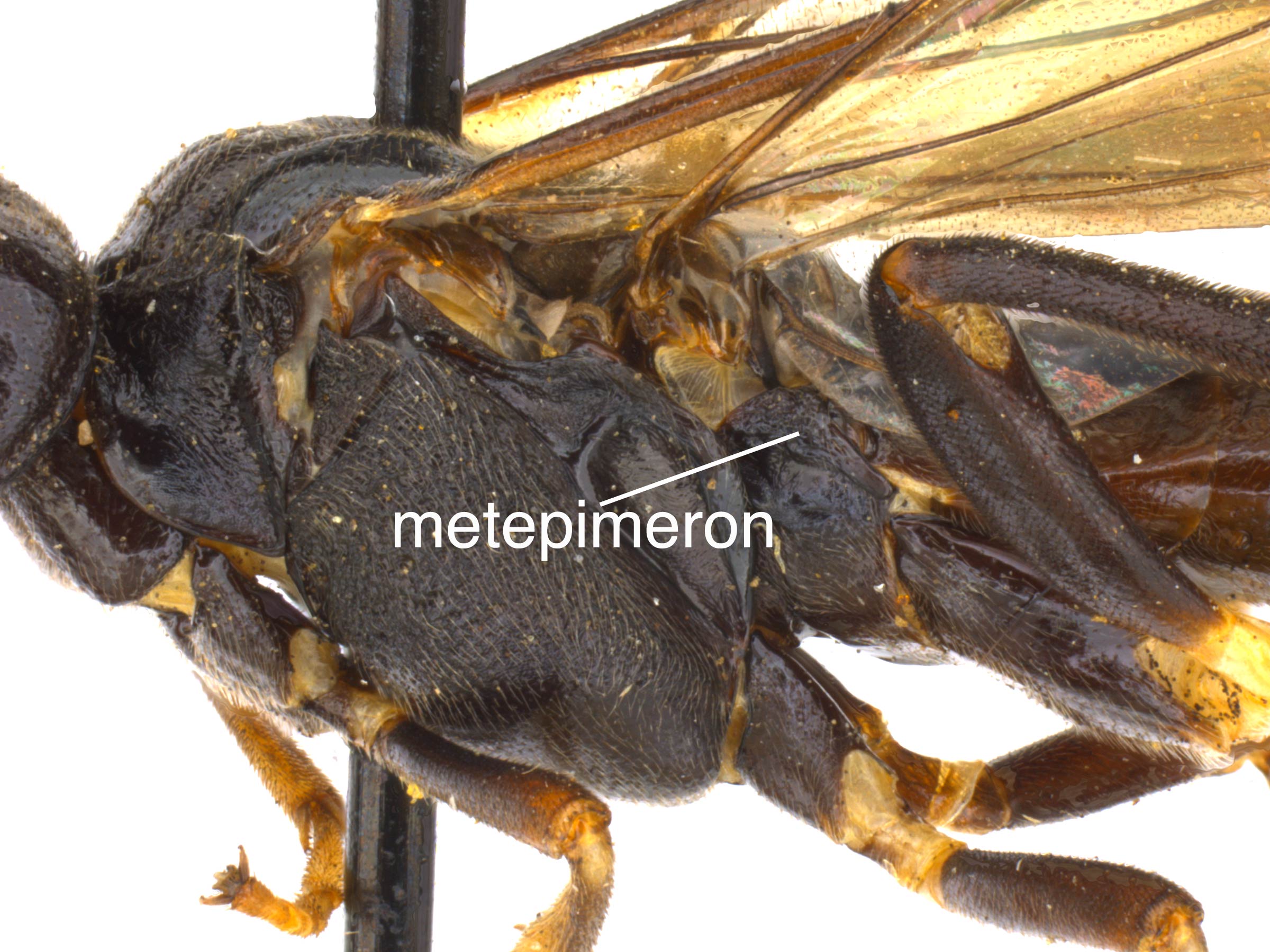 separated from metepisternummetepisternum:
separated from metepisternummetepisternum: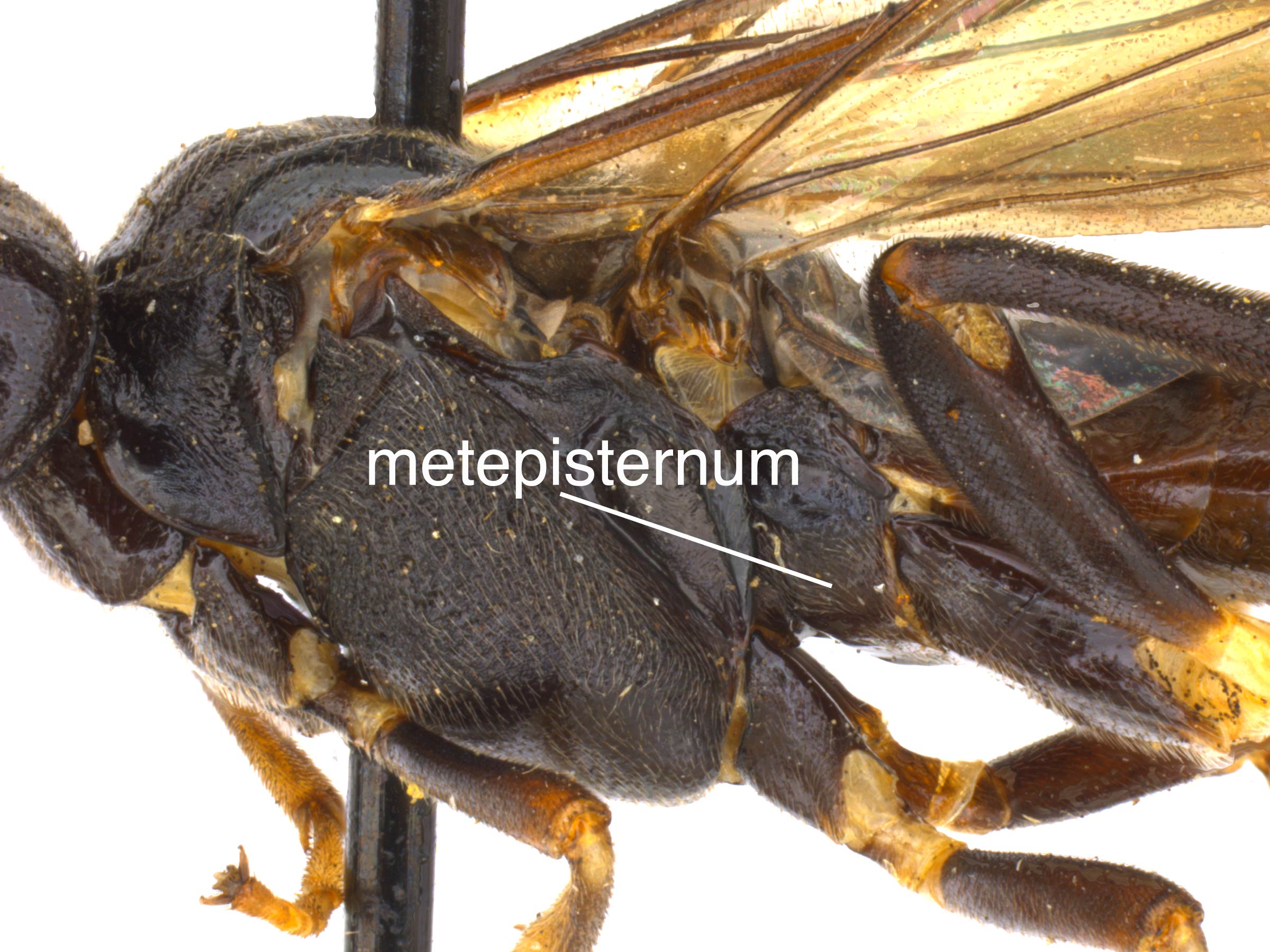 by distinct furrowfurrow:
by distinct furrowfurrow: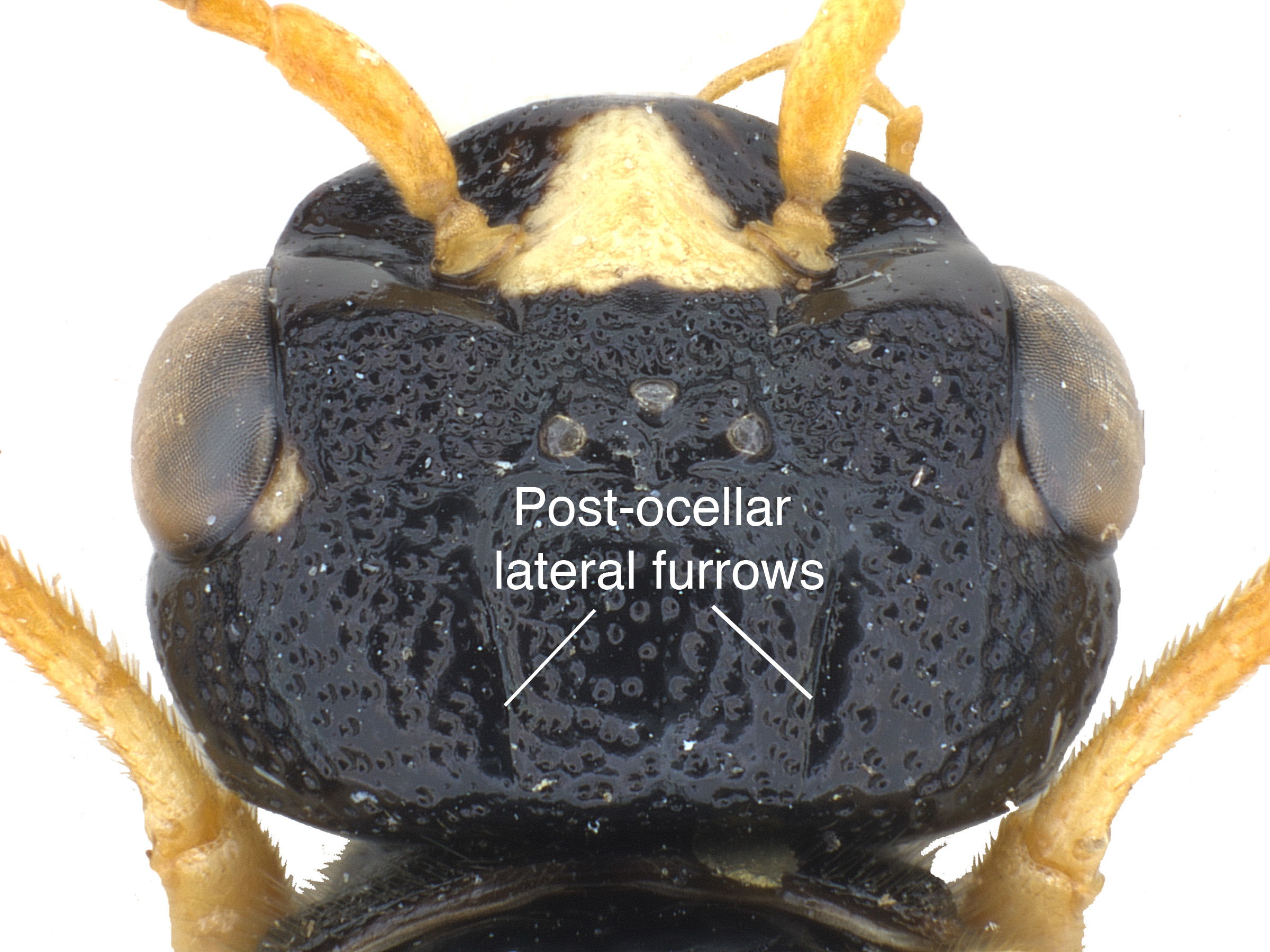 (Goulet 1992Goulet 1992:
(Goulet 1992Goulet 1992:Genus characters
 margin straight or slightly shallowly emarginated (Goulet 1992Goulet 1992:
margin straight or slightly shallowly emarginated (Goulet 1992Goulet 1992: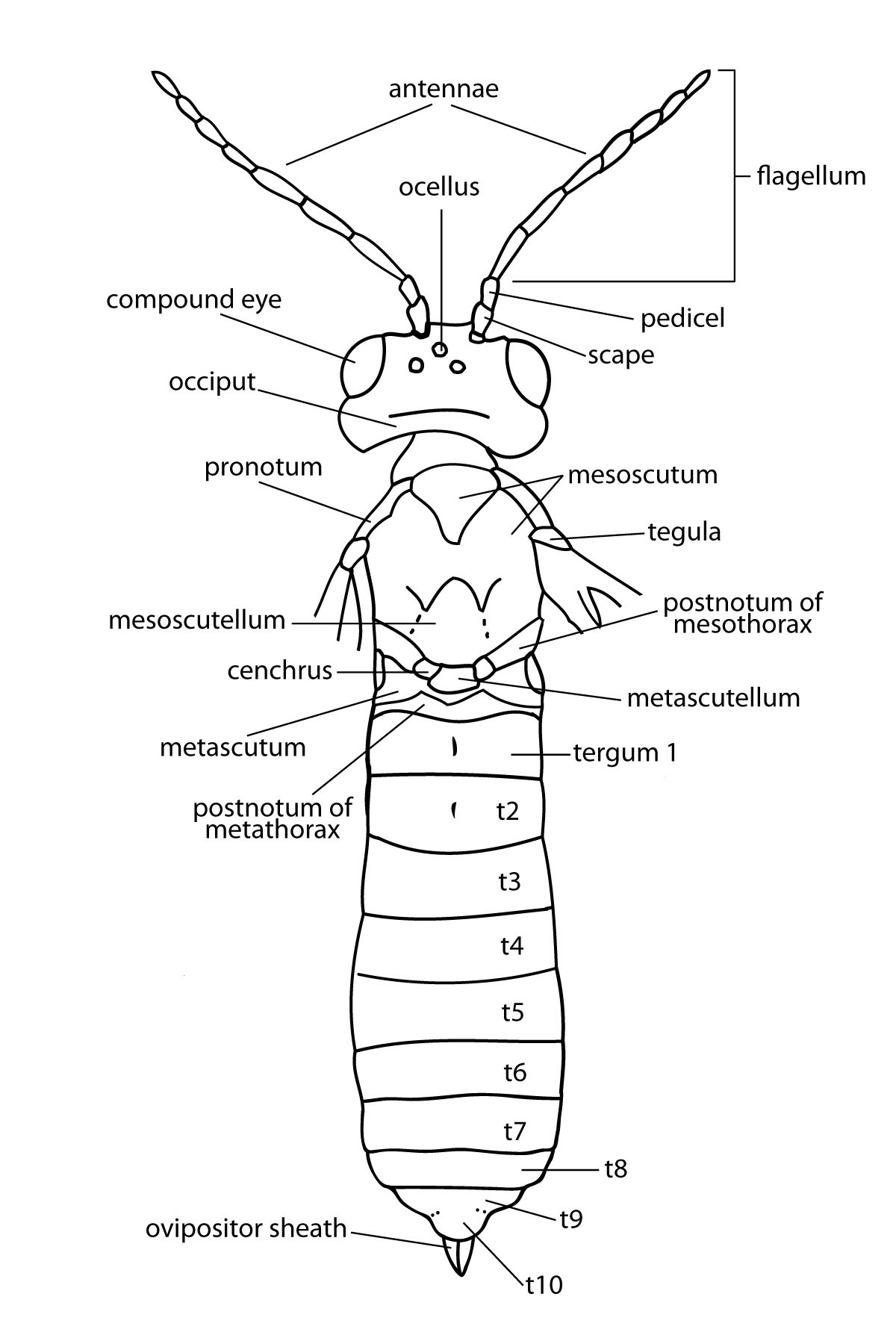 ridge extending from mandiblemandible:
ridge extending from mandiblemandible: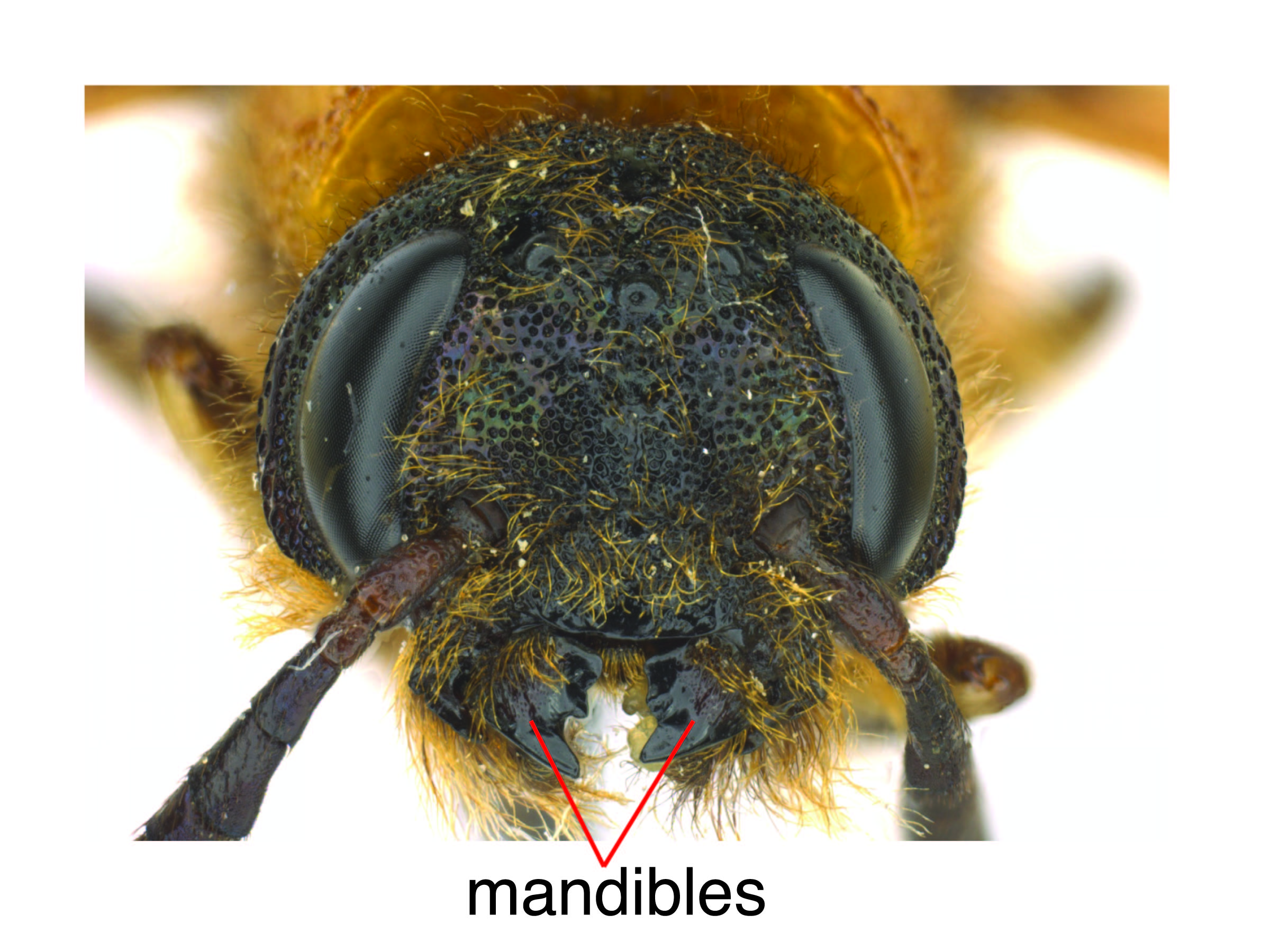 to near post-ocellar area (Goulet 1992Goulet 1992:
to near post-ocellar area (Goulet 1992Goulet 1992: vein 2A+3A complete, connected to 1A by crossveincrossvein:
vein 2A+3A complete, connected to 1A by crossveincrossvein: anal crossveinanal crossvein:
anal crossveinanal crossvein: vein 2r present (Goulet 1992Goulet 1992:
vein 2r present (Goulet 1992Goulet 1992: vein M intersecting Sc+R basalbasal:
vein M intersecting Sc+R basalbasal: veins 1m-cu and Cu1 120°–150° (Goulet 1992Goulet 1992:
veins 1m-cu and Cu1 120°–150° (Goulet 1992Goulet 1992: anal crossveinanal crossvein:
anal crossveinanal crossvein: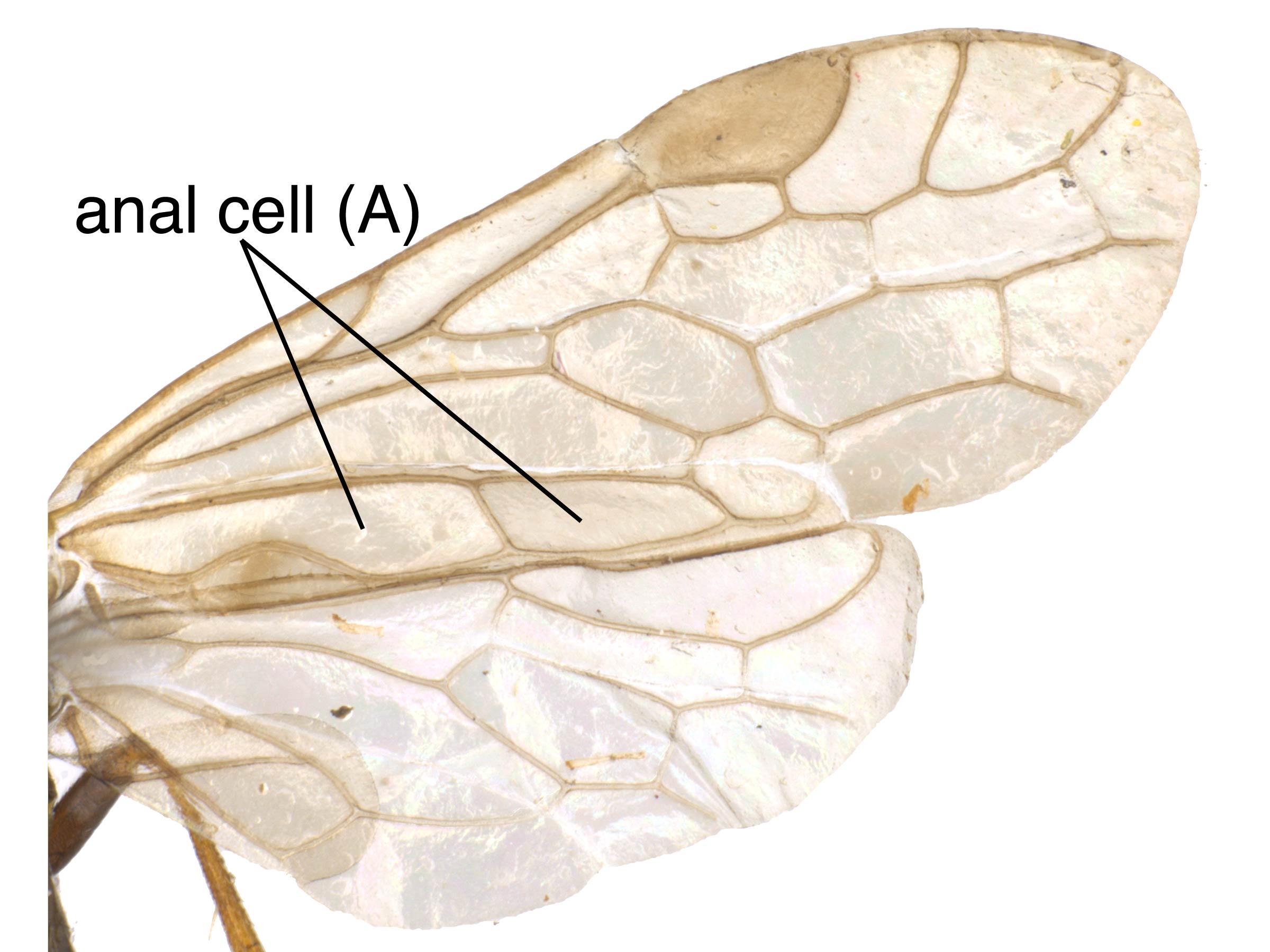 (Goulet 1992Goulet 1992:
(Goulet 1992Goulet 1992: distinctly angled on lower posterior corner (Goulet 1992Goulet 1992:
distinctly angled on lower posterior corner (Goulet 1992Goulet 1992: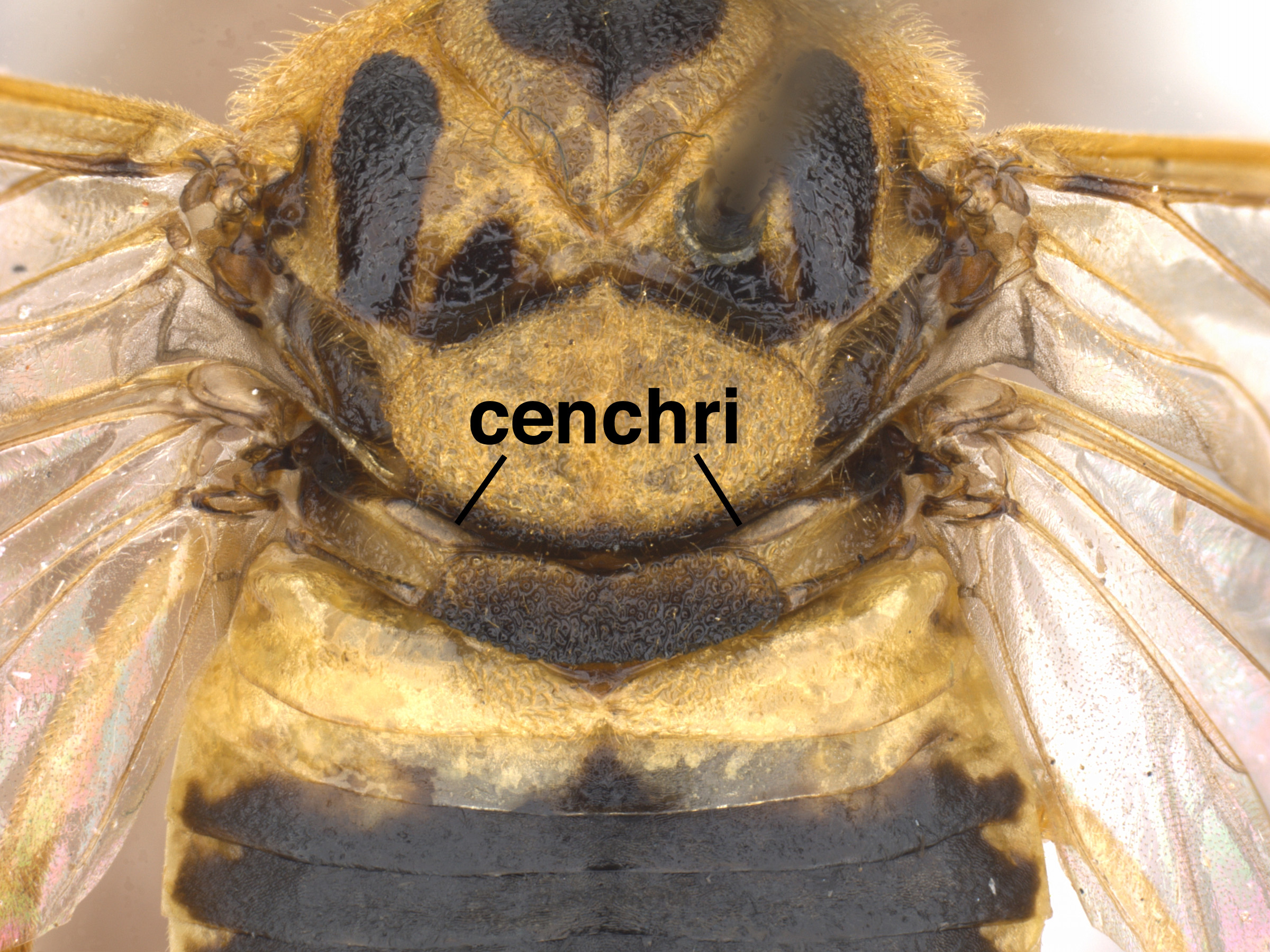 3–5X medial length of postnotumpostnotum:
3–5X medial length of postnotumpostnotum: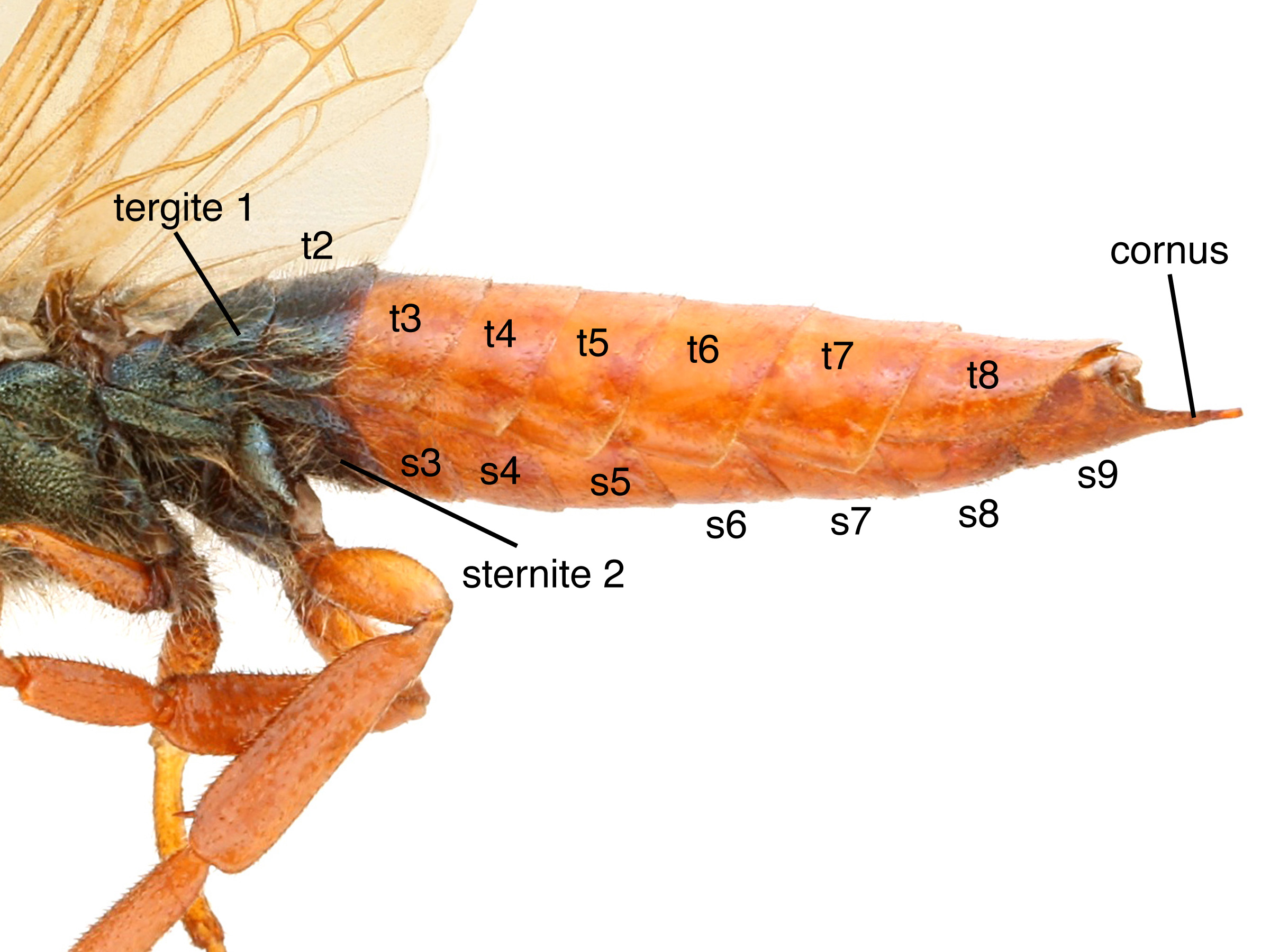 wide medially; membranous area small (Goulet 1992Goulet 1992:
wide medially; membranous area small (Goulet 1992Goulet 1992: bifidbifid:
bifidbifid: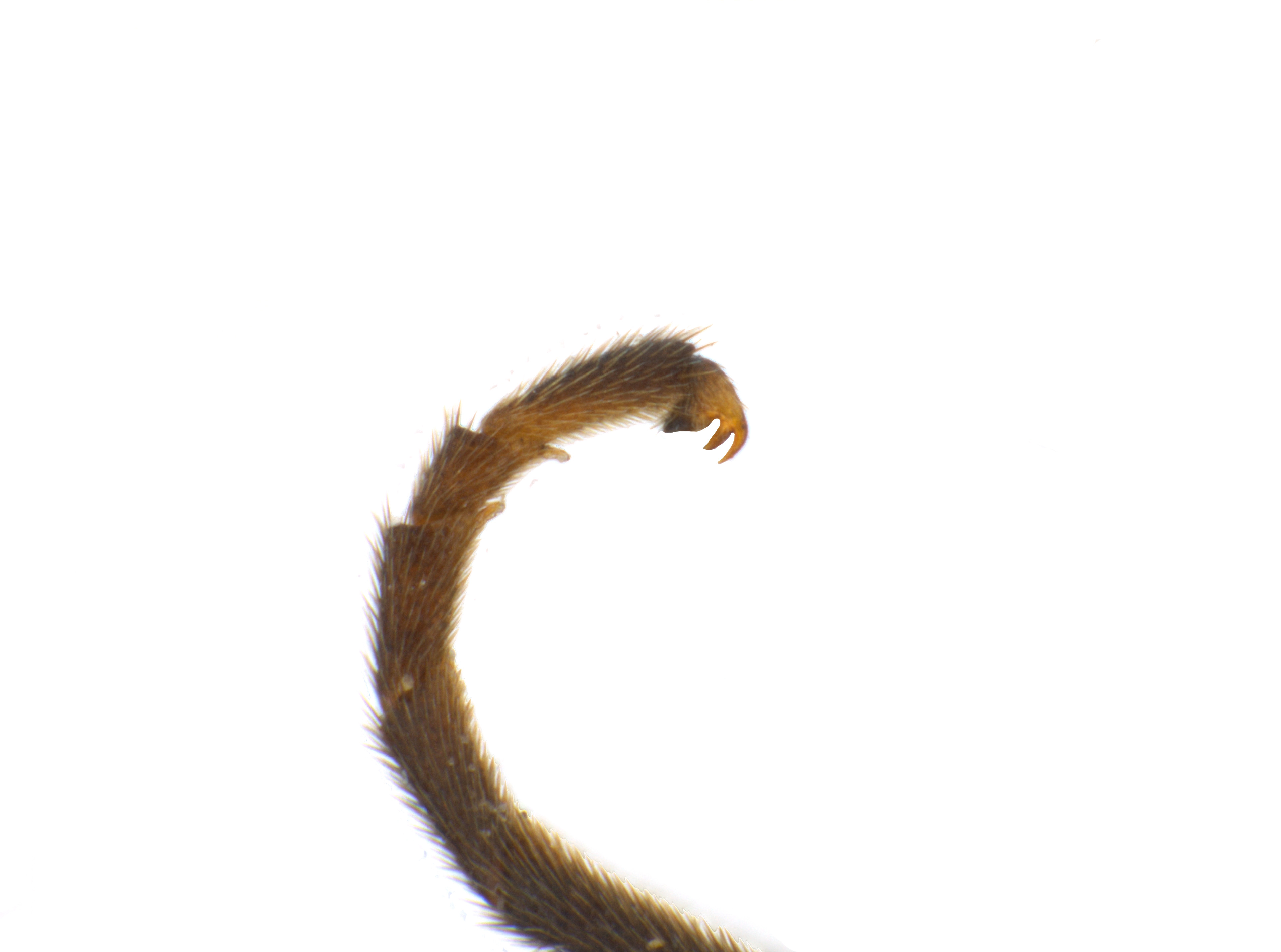 without basalbasal:
without basalbasal:Filacus can be confused with similar species in the subfamily Tenthredininae. It can be distinguished from most other genera by the angle on the posteroventralposteroventral:
describes location towards the back on the underside of the body; posterior and ventral
area of metepimeronmetepimeron:
the dorsal portion of the metapleuron
 , and from closely related Zaschizonyx by the shallowly notched or straight clypeusclypeus:
, and from closely related Zaschizonyx by the shallowly notched or straight clypeusclypeus:
sclerotized area on the front of the head located between the antennal insertions and labrum
 (Goulet 1992Goulet 1992:
(Goulet 1992Goulet 1992:
Goulet H. 1992. The genera and subgenera of the sawflies of Canada and Alaska: Hymenoptera. Symphyta. The insects and arachnids of Canada. Part 20. Agriculture Canada Publication.).
none
Filacus larvaelarva:
the immature stage of holometabolous insects
 feed on plants of several families. Confirmed hosts include Phacelia (lacy phacelia), Amsinckia (fiddlenecks), and Ranunculus (buttercup) (Smith and Gibson 1984Smith and Gibson 1984:
feed on plants of several families. Confirmed hosts include Phacelia (lacy phacelia), Amsinckia (fiddlenecks), and Ranunculus (buttercup) (Smith and Gibson 1984Smith and Gibson 1984:
Smith DR and Gibson GAP. 1984. Filacus , a new genus for four species of sawflies previously placed in Macrophya or Zaschizonyx (Hymenoptera: Tenthredinidae). Pan-Pacific Entomologist 60 (2): 101-113.).
Adult Filacus have been observed visiting a variety of flowers from several plant families and carrying pollen on their bodies, making them a potential pollinator. It is not known if the adults feed on the nectar, pollen, or other flower parts (Smith and Gibson 1984Smith and Gibson 1984:
Smith DR and Gibson GAP. 1984. Filacus , a new genus for four species of sawflies previously placed in Macrophya or Zaschizonyx (Hymenoptera: Tenthredinidae). Pan-Pacific Entomologist 60 (2): 101-113.).
unknown
World: This genus is only known from North America (Taeger et al. 2010Taeger et al. 2010:
Taeger A, Blank SM, and Liston AD. 2010. World Catalog of Symphyta (Hymenoptera). Zootaxa 2580: 1-1064.).
North America: Filacus is recorded in several counties in California and Arizona, south into Baja California Norte (Smith and Gibson 1984Smith and Gibson 1984:
Smith DR and Gibson GAP. 1984. Filacus , a new genus for four species of sawflies previously placed in Macrophya or Zaschizonyx (Hymenoptera: Tenthredinidae). Pan-Pacific Entomologist 60 (2): 101-113., Smith 2003bSmith 2003b:
Smith DR. 2003b. A Synopsis of the sawflies (Hymenoptera: Symphyta) of America south of the United States: Tenthredinidae (Nematinae, Heterarthrinae, Tenthredininae). Transactions of the American Entomological Society 129 (1): 1-45.).
Map data from: GBIF.org (29 October 2019) GBIF Occurrence Download Filacus and the Smithsonian National Museum of Natural History Entomology Collection (USNM)
Details about data used for maps can be found here.